Menu
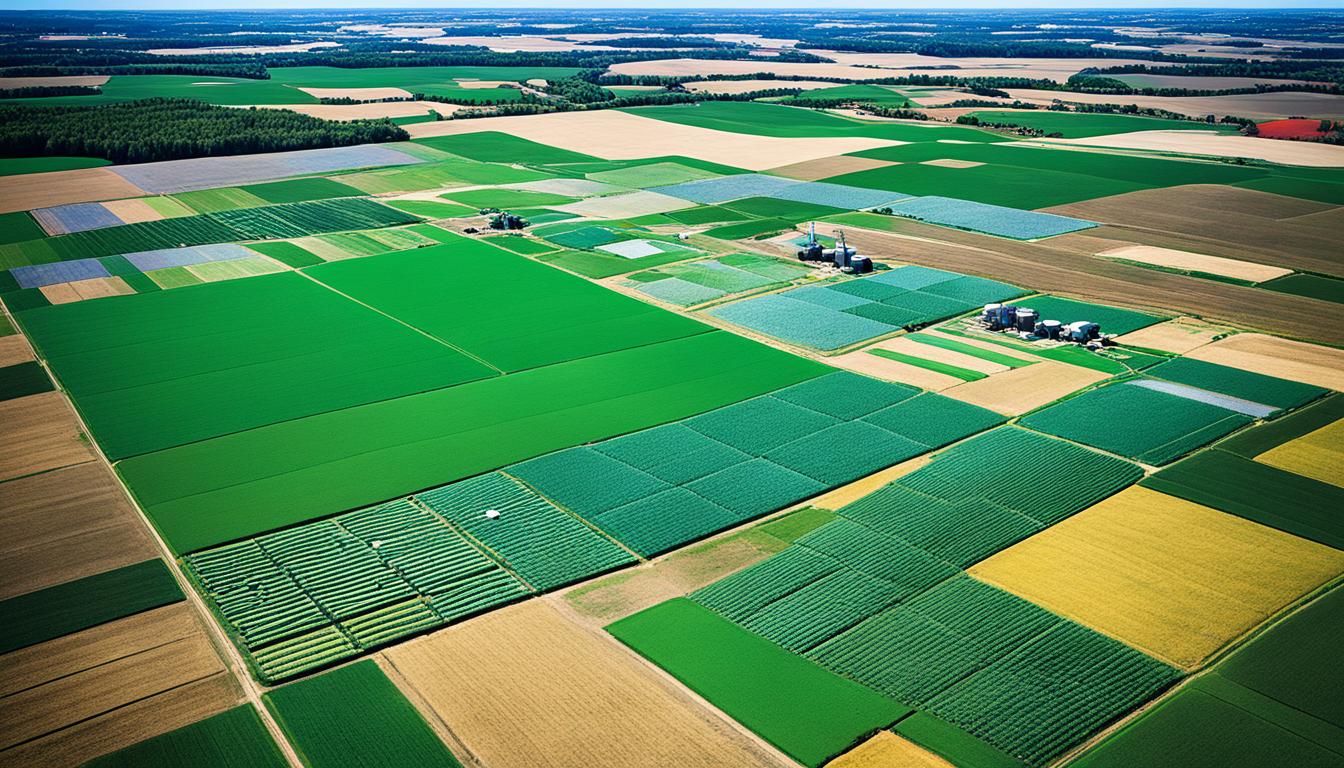
Did you know that adding IoT sensors to farming can increase crop yields by up to 15%? This method also makes the use of resources more efficient. Real-time monitoring in the fields with tools like IoT is changing how we farm.
These tools are advanced, tough, and built to last, even in harsh farm environments. With IP67 ratings for dust and waterproofing, they’re reliable. They can do everything from checking soil moisture to monitoring crops and temperature. Now, farmers have the power to make smarter choices in their farming.
IoT devices and sensors are changing agriculture. They offer worldwide connectivity, letting farmers check their farms any time. This change brings technology and farming closer, making farming both smarter and more sustainable.
Agricultural sensor technology changes how we farm now. This tech lets us gather important data right away. It helps us use resources smartly, check machines closely, and run farms better. Thanks to these new tools, farms today are more ready for eco-friendly and productive farming.
Thanks to sensor networks for agriculture, farmers know more about things like soil moisture, air humidity, and temperature. This deep insight is key in giving crops exactly what they need. This cuts down on waste and creates the best conditions for growth. So, we’re getting more crops while taking care of the environment.
IoT in farming is growing fast. It was worth $11.4 billion in 2021, and it’s set to hit $18.1 billion by 2026. These numbers show more and more farmers are choosing high-tech ways to manage farms. And the whole world is moving this way, with IoT expected to be huge by 2028.
But IoT does more than help with crops. It’s also about keeping an eye on animals, saving energy, and making sure machines work well. Key here are systems that water crops only as much as they really need. These let us save water and power. They show how vital agricultural sensor technology is for modern farming.
Starting with IoT can be hard and costly. But the good it brings is way bigger. It lets farmers make smart choices based on data. This helps farms be friendly to the planet and the pocket. Looking forward, IoT will be critical for farming to keep getting better worldwide.
Today, in farming, many sensors collect detailed information about the environment. These sensor networks are essential. They help gather environmental data to improve how farms are managed and the amount of crops grown.
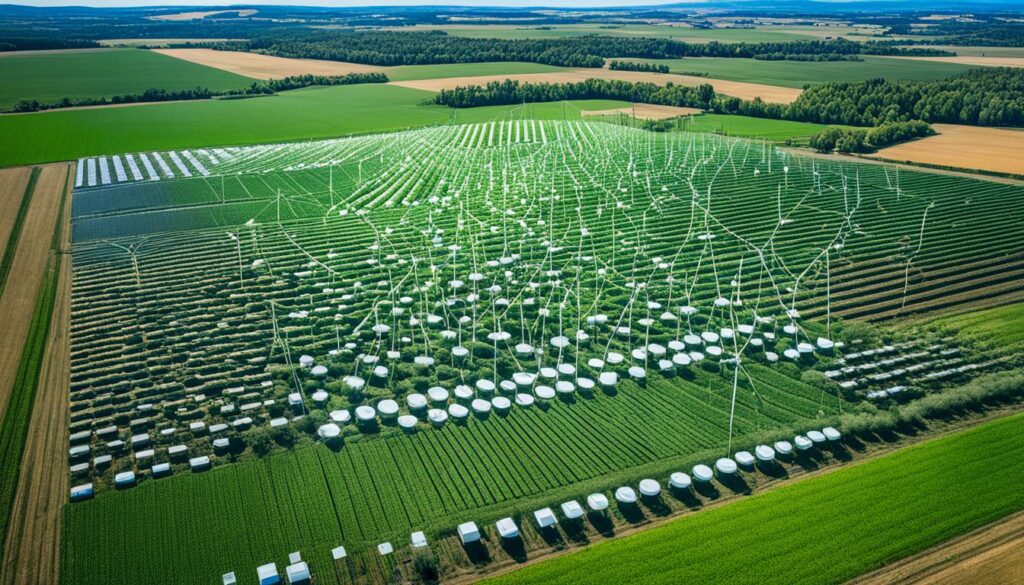
Soil moisture sensors are key in precision farming. They check how much water is in the soil very accurately. This allows farmers to water their fields just right, using water better. Crops get the perfect amount of water, helping them grow well.
Thermometers are crucial for checking the weather and the state of machines. They tell farmers about upcoming weather and help them protect their crops. With these sensors, farmers can keep their fields at the best temperature. This makes crops better and more of them.
Light sensors, like cameras, look at the earth and the sky, and they look at plant colours. These sensors help plants get just the right amount of sunshine. So, farmers can change how they grow their crops to make sure the plants do well.
Lots of sensors work together to watch the environment closely and improve farming methods. This mix of tech means data is checked quickly and helps farmers make good choices. It’s all very important for farming now.
These sensor tools are changing farming from the old way to smart farming. This new way helps farmers grow more food in a smarter, better way.
Farm monitoring sensors are changing agriculture for the better. They collect and analyse data in real-time. This gives us key information about the farm quickly, helping with fast decisions.
Good farm management starts with knowing what is going on. These sensors are great at getting immediate data on things like soil moisture and crop health. This speed in getting data helps farmers react fast to any changes, making their farms run smoother.
Smart farming benefits a lot from these sensors. They let farmers keep a close eye on water and nutrients. With this data, farmers can use water and nutrients better. This means less waste and more savings. Plus, AI and machine learning tech help make these strategies even better.
Using farm sensors can lead to higher crop yields. They help spot and fix plant health problems early. This saves crops and boosts how much is grown. Farmers can also use sensor data to make growing conditions perfect. This means their crops grow better.
| Benefits | Details |
|---|---|
| Real-time Data Collection | Immediate response to changing field conditions |
| Optimised Resource Management | Efficient water and nutrient use, reduced waste |
| Increased Crop Yields | Early detection of issues, improved productivity |
In the end, farm sensors are key for smart farming. They help with quick data, better resource use, and higher crop yields. These tools are crucial for agriculture’s future. They help make farming more sustainable and efficient.
Soil moisture tech is key for precision farming gear. It gives farmers the data they need to smartly use water. This means using the right amount of water at the right time. This way, farmers grow healthier crops while using less water.
Since the 1950s, neutron probes have been measuring soil moisture well. But now, we have newer, quicker tools like electromagnetic sensors. These sensors check soil moisture fast and very accurately. They tell us how hard plants have to work to get water, which is very useful info.
When we connect these tools to the Internet of Things (IoT), it gets even better. Farming becomes smarter with precision irrigation. Getting updates in real time helps farmers water smarter. For example, satellites look at fields from above to measure moisture accurately. This way, water goes where it’s needed the most.
Mixing soil moisture data with weather and plant info helps farmers do more with less. It supports farming that’s good for the earth. There are strict ways to set up these tools to get the best results. Groups tell farmers how to do this. They make sure farmers are using these tools right to help their crops and use water better.
More than just new tools, soil moisture sensors show that farming is getting smarter with data. But, not many farms in the U.S. are using them yet. This could change as more farmers see the benefits. After all, using these tools leads to better crops and less water waste.
Here’s a look at what different soil sensors cost. This shows the money side of using these tools for smart farming:
| Sensor Type | Cost per Sensor (USD) |
|---|---|
| Capacitance Sensors | $250-350 |
| TDR Sensors | $250-350 |
| Neutron Probes | ~$10,000 |
| Tensiometers | $80 |
| Granular Matrix Sensors | $40-50 |
Checking temperature and other environmental facts are super important in farming today. Farmers use smart sensor systems to react to climate changes. This helps in agriculture.
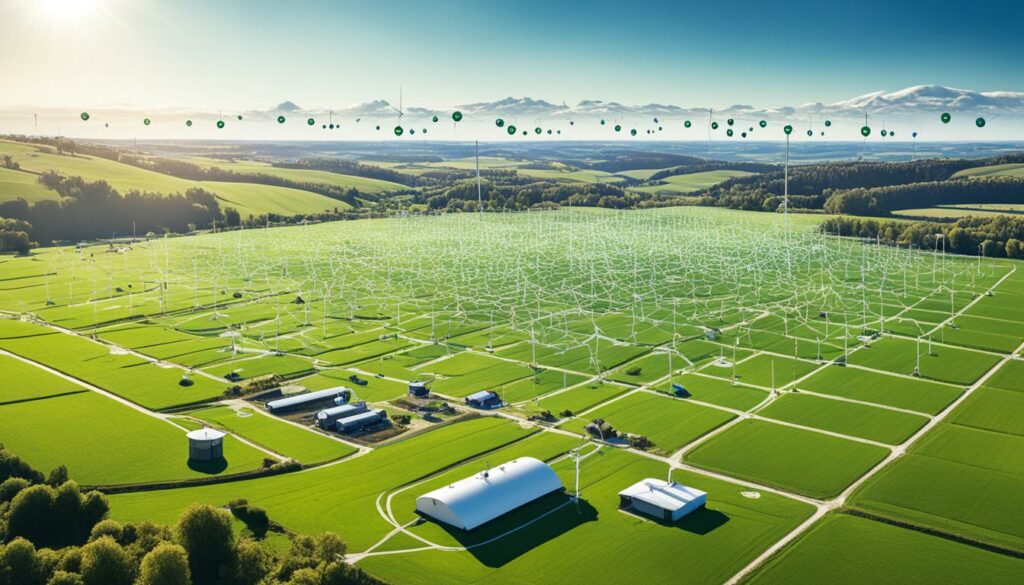
Temperature and humidity really impact how well crops grow. Swift Sensors’ tools can measure temperatures from -40°C to +60°C (-40°F to +140°F). This gives crucial info on the surroundings. Handling humidity is also key. Their gadgets make it easy to control both factors, making the perfect grow environment.
Swift Sensors has over 30 sensor types. This includes open/close sensors and wireless voltage monitoring. Such tools find issues fast, like leaks, and help fix them before they harm plants or equipment.
Looking ahead in weather is a big win with these sensors. Farmers get real-time and historical weather data. This helps them prepare for bad weather. The Swift Sensors system can monitor over 300 feet and work with 150 sensors.
Great analysis and a strong cloud platform make information easy to access. For $65 a year, farmers get constant updates however they prefer, like calls, emails, or texts.
Using this tech boosts work efficiency and protects against bad weather. It’s a must-have for keeping crops healthy and doing better in farming.
Managing farm tools well is key to doing well in agriculture. I use farm monitoring sensors and IoT sensors for farms to keep my machines working for longer and better. By sticking to a regular check-up plan, I cut down on surprise breaks and make sure my equipment lasts.
It’s crucial to keep a detailed record of when machines were last looked at. This helps decide when to fix or get new equipment. Doing this makes sure everything runs smoothly and stops those times when the work stops unexpectedly.
Using smart technology, farmers can collect real-time data on various aspects such as operating hours and fuel consumption, which aids in optimising equipment usage and conserving resources.
Today’s farm machines come with GPS and telematics for keeping track of how they’re doing. This fast check helps save money by fixing problems before they get big. Also, using farm software for keeping an eye on maintenance, costs, and scheduling makes managing the farm better.
Adding IoT sensors for farms does more than keep track of machines. It also helps keep an eye on animals’ health and whereabouts. Using sensors this way not only makes the farm more productive but also safer and better for the environment.
In today’s world, farming has changed a lot with new technology. Precision agriculture uses advanced tools to make farming better. These tools get information from sensors and help farmers use resources smarter. This makes farms more productive and efficient through smart farming.
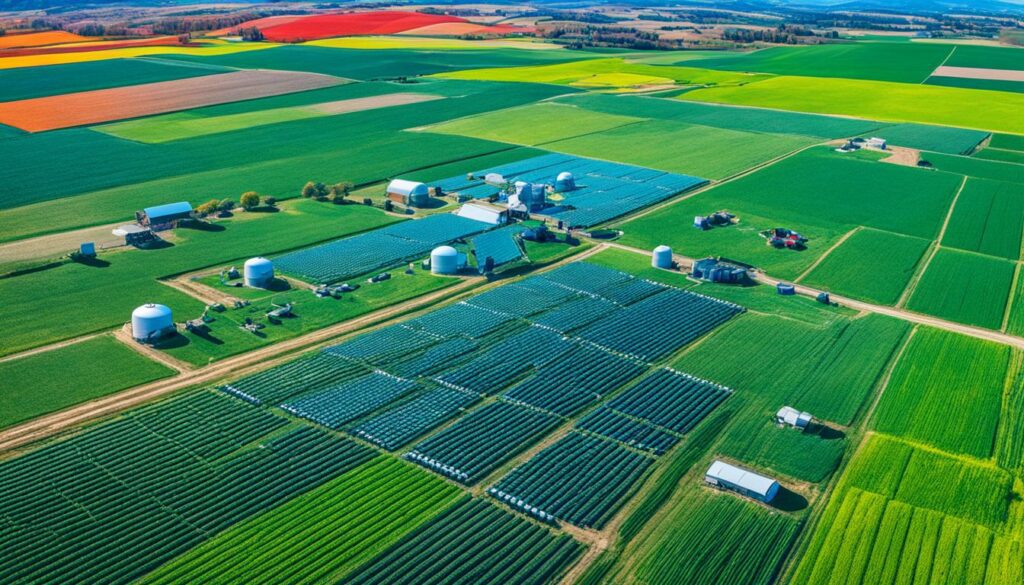
Smart irrigation systems are vital in precision agriculture. They use sensors to check soil moisture and give crops water when they need it. This approach saves water and helps crops grow better. Farmers can also keep an eye on water levels and get alerts when they run low.
Automated fertiliser devices are also important in modern farming. They use data from sensors to feed crops the right amount of nutrients. This keeps the soil healthy and makes crops grow their best. These devices also cut down on waste, helping the environment.
By using smart farming, the future of agriculture looks bright. Farmers can do many things, like track their equipment with sensors and make crops healthier with special tools. These new ways help farmers work better and get more done.
Integrating sensor data with IoT platforms transforms agriculture, leading to smarter farming. By using agricultural sensor technology, farms collect and process big data from many remote monitoring devices. This means farm management is guided by detailed sensor data analytics, aiding quick decisions and improving operations.
The use of IoT in farming is growing fast, from $15.178 billion in 2023 to $71.753 billion by 2030. These IoT platforms work well with different sensor data, even from different companies. This allows for easy communication between sensors, giving a clear total view of farm conditions.
A good IoT data platform in farming should collect, store securely, process well, and analyse data deeply. It should also be good with privacy, manage devices well, and easily work with other systems through APIs. The ability to handle large amounts of data and work in areas with poor network is key.
IoT platforms in farming can do a lot, like monitor weather, check soil health, and manage irrigation. They help make irrigation more efficient with accurate soil moisture data. Real-time weather data can also be used to predict conditions, protecting crops and improving productivity.
When setting up an IoT platform, it’s important to check if it works with farm equipment and the cost. Making sure it exchanges data well with other systems and keeps data safe is crucial too.
The focus on data-driven agriculture, thanks to IoT, helps farmers to make smart decisions. This leads to better crop yields and more sustainable farming. It shows how agriculture is moving towards precision and intelligent farming.
In today’s world, staying connected globally is crucial for effective remote farming. Thanks to modern sensors, farmers can keep an eye on their fields from anywhere. This is possible because of strong technologies including Cellular IoT, LPWA networks, LoRaWAN, and Bluetooth.
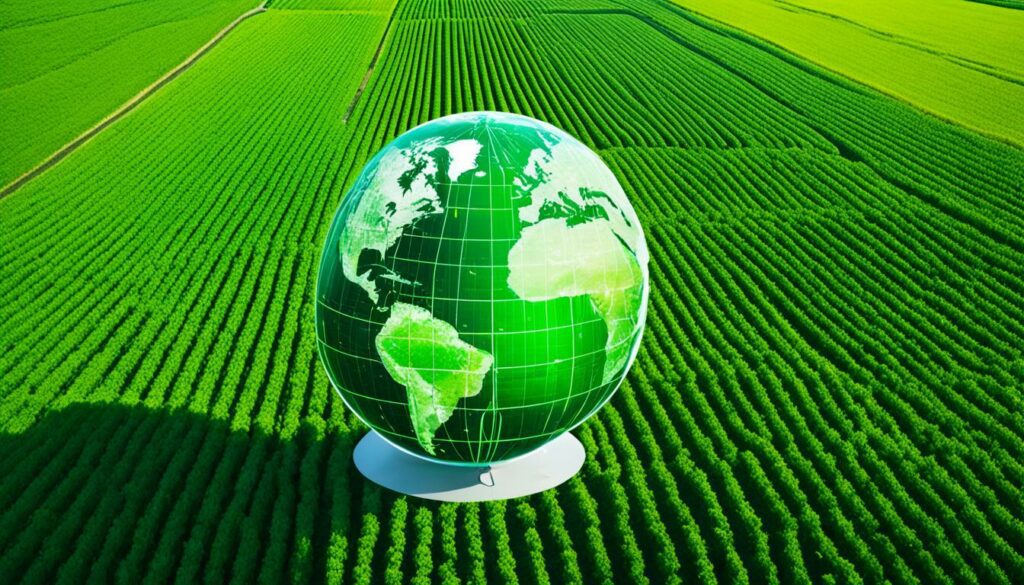
Systems based on IoT use different Cellular IoT networks like 2G, 4G LTE-M, and NB-IoT. They ensure data flows smoothly from monitoring devices to farmers. These networks help with integrating sensor technology into farming, saving resources, reducing waste, and boosting yields.
The data from the sensors gives farmers real-time info on soil moisture, temperature, and other key details. This helps them manage their farms more effectively.
LoRaWAN and Bluetooth are also key for global farm connectivity. LoRaWAN is great for large farms as it can cover long distances with little power. Bluetooth, however, is better for smaller areas because it’s cheaper and for close-range connections.
With these technologies, farmers can set their devices to update regularly or alert them to critical conditions. This means no aspect of farm management gets missed.
To sum up, let’s look at the benefits and uses of these technologies in a table:
| Technology | Range | Application | Benefits |
|---|---|---|---|
| Cellular IoT | Long-Range | Large-scale Farms | Seamless Data Flow, Enhanced Productivity |
| LoRaWAN | Long-Range | Extensive Fields | Low Power Consumption, Broad Coverage |
| Bluetooth | Short-Range | Greenhouses, Small Farms | Cost-Effective, Easy Installation |
By using these tools well, farmers can make choices based on data. This helps them use resources better and increase their farm’s production. Including IoT in farming marks a big step in sensor technology for agriculture. It leads to a more connected and efficient farming world.
Environmental data collection is key in modern agronomy. It uses many methods to watch climate and soil. At the GrowWise Center in Eindhoven, 1,600 readings are taken every ten minutes. This helps with ongoing research, ensuring agricultural precision.
Sensors are crucial for gathering this data. They catch problems early, like changes in temperature. This keeps the growing conditions just right and lowers the risk of crops failing.
Signify and others are using AI to link growth conditions with results. This aims to forecast the best growth conditions. It also provides custom solutions for farmers, boosting productivity.Remote monitoring devices make these solutions even better.
Mixing sensors and data platforms with cloud tech makes them more useful. These tools not only keep an eye on growth but also find and fix problems fast. In vertical farming, AI and machine learning help spot plant issues quickly, leading to fast fixes.
| Data Collection Approach | Main Benefits |
|---|---|
| Continuous Sensor Monitoring | Early detection and proactive response to environmental changes |
| AI-based Algorithm Training | Prediction of optimal growth conditions |
| Cloud Integration | Enhanced monitoring and rapid development of growth recipes |
Under the Horizon 2020 Internet of Food program, a powerful sensor platform has been launched. This platform collects and shows key data for plant experts and farmers. It helps improve solutions continuously.
Using smart farming solutions can change how well farms work. These solutions include new tools and sensors that give farmers important information. This information helps farmers grow more crops and run their farms better.
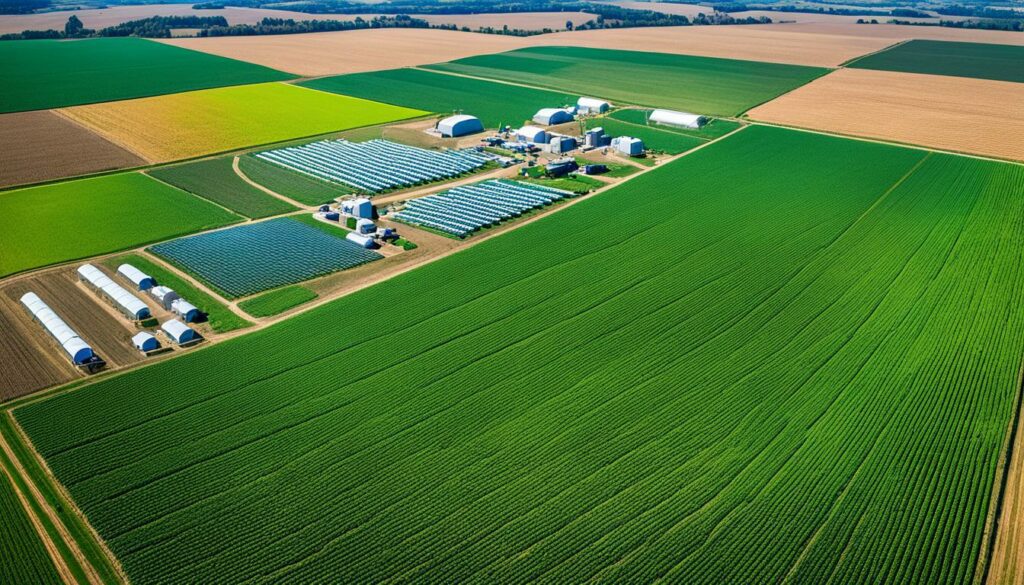
Picking the right sensors is key to making smart farming work. Make sure the sensors match what your farm needs to do. You’ll need sensors to check soil moisture, temperature, and keep an eye on your crops. Each sensor does something special. By choosing the best mix, you get all the data you need.
After choosing the sensors, installing them correctly is vital. It takes careful planning to set them up for the best results. This ensures the data they gather is correct.
Doing these steps right helps your farming tools and sensors work better. This helps make your farm smarter and more successful.
Bringing in sensor data analytics changes how farmers make decisions. They can use data from weather, soil, and crops to predict and prevent problems. This makes their work more efficient.
Weather data gives key info like temperature, rain, and wind. This info is critical for crop growth. Farmers use this to anticipate bad weather and plan better.
Soil data is just as important. It tells farmers about the soil’s type, nutrients, and water. Knowing this helps farmers care for their crops better.
Looking at crop data helps farmers know their plants’ health. They use drones to check crops from above. This way they can spot problems early.
High-tech cameras on satellites show detailed farm views. They help find issues like pests or drought. This lets farmers act fast to save their crops.
With predictive analytics, farmers can guess their crops’ future output. This helps them use their resources better and lower risks. Advanced tools like artificial intelligence make this possible.
Data analytics also fights against risks like bad weather and pests. It uses smart tech to make farming smarter and more stable. Big companies, such as Monsanto, are using these tools to make better choices.
In the end, sensor data analytics gives farmers the power of knowledge. They can use their resources better and improve their crop care. It’s a must-have in today’s farming world.
Agricultural sensor technology has some hurdles to jump. The high cost stops many small and medium farms from investing. Large farms, over 5,000 acres, show more interest at 81%. But, only 36% of small farms can take the financial hit. This shows the struggle for small farm owners.
The tech part is also hard. Setting up and using sensor networks for agriculture needs specific know-how. Many farmers don’t have these skills. Teaching these is important but takes time and money. Plus, dealing with lots of sensor data needs smart software.
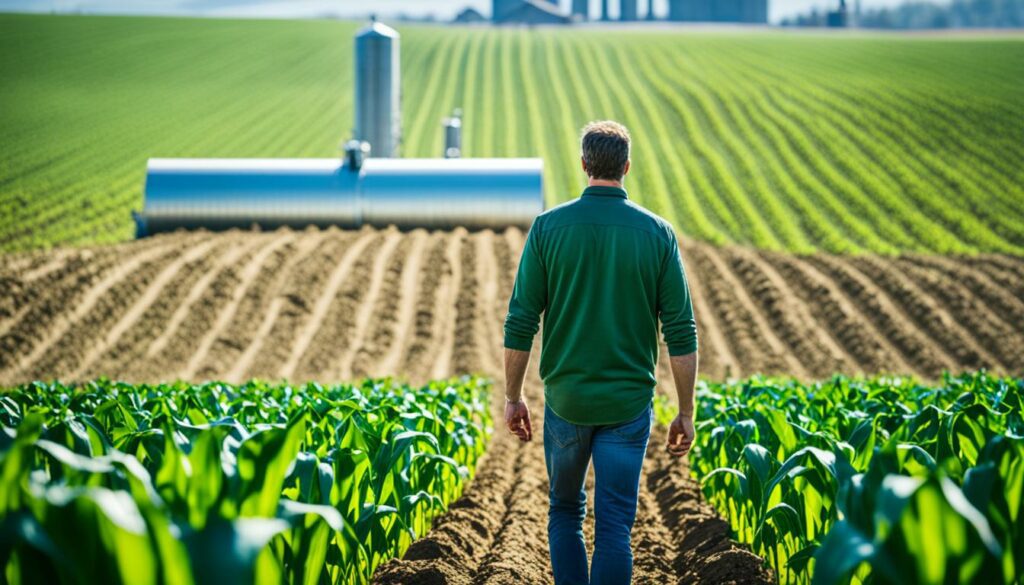
Where you farm can slow things down too. Bad internet in rural spots makes getting real-time data tough. South America’s adoption rate is at about 50%. But, in Europe and North America, it’s 61%. This shows internet availability really makes a difference.
Keeping sensors accurate isn’t easy. They need regular checks to stay right. A small mistake can lead to big problems in how farmers make choices. Getting the data right is key to making the most of these tools.
And then there’s safety and privacy. With more data flying around, the risk of it getting into the wrong hands grows. This scares farmers who rely on these details to run their farms. Strong security is a must to make sensor networks in agriculture work.
But, farmers need to tackle these issues to make the most of IoT and sensors. These new tools can really change how farming works.
The precision agriculture market is growing fast, set to reach USD 9.4 billion in 2022 with a 12.6% annual growth. This growth is driven by key trends in agricultural sensor technology. These trends improve how farmers gather and use data.
One key trend is the close connection of AI and IoT. This makes environmental data collection more accurate. It helps farmers make better decisions with the data they collect.
There is a rise in using autonomous farm machines. Companies like Trimble are leading the way to fully automated farming. This tech boosts efficiency and gives farmers precise control over their farms. It allows for very detailed environmental data collection, covering things like soil temperature and moisture.
Personalised farming is also becoming popular. By using agricultural sensors, farmers can tweak their methods for different crops. This ensures the best conditions for each crop, leading to better growth.
Many new companies are working on green and smart farming solutions. These efforts are making agriculture more eco-friendly and efficient. The use of IoT in agriculture is growing rapidly, especially with tools like smart irrigation systems. These systems can save a lot of water and boost crop production.
Last but not least, the push towards more sustainable farming practices is strong. Precision agriculture is at the heart of this change. By combining AI, robotics, and precise positioning, farming becomes less harmful to the environment. These steps also boost farming’s productivity and efficiency.
The use of smart technology in farming is changing the game. It’s moving us towards agronomy that relies on data. With the world’s population set to hit 9.7 billion by 2050, farming smarter is more important than ever. And through precision farming, we can be more careful with the environment while using things like fertilisers and pesticides more wisely.
Farmers are now using the Internet of Things (IoT) to keep an eye on their fields. IoT devices give them info right away about their crops and animals. This helps them make quick decisions and helps things grow better. So, this move to smart farming is helping to grow more food in a way that doesn’t harm the planet.
Devices such as AMS are full of sensors that can check things like soil and air. They help farmers see how their crops are doing and what the weather is like. By 2050, these tools could help farmers make 70% more food, IBM says. Plus, tools like EOS Monitoring let them check on their fields from far away, bringing in even more useful info.
These new sensor technologies are really important for the future of farming. We need to welcome these advances to make farming better for the planet and more successful. Smart farming and monitoring tools are key. They’re turning old ways of farming into new, efficient, and productive ones. This is how we make sure we can feed more and more people.
IoT sensors track soil moisture, temperature, and light in real-time. This data helps farmers adjust their practices. They can make the right choices to grow healthier crops and improve their harvests.
IoT connects different sensors across the farm. These sensors gather and send important data. Analyzing this data helps farmers manage resources better, work more efficiently, and increase their farm’s productivity.
In farming, you often see soil moisture, temperature, and light sensors. These sensors give farmers specific information. They support better crop management and yield improvement.
Sensors on the farm collect data in real-time. This data helps farmers manage their resources better. It reduces waste and increases crop yield. In the end, farms become more efficient and eco-friendly.
Soil moisture sensors measure how much water the soil holds. Farmers use this data to water crops effectively. It helps keep crops healthy while saving water.
Temperature and environmental sensors watch the weather. They let farmers protect crops from bad weather and plan better. This improves how crops grow and how many are produced.
IoT sensors keep an eye on how farm equipment is used and its performance. This information helps schedule regular maintenance. It means the farm runs smoother, saving time and money on repairs.
Precision farming uses smart systems for watering and applying fertilisers. These systems, guided by sensor data, use resources carefully. They help crops grow well while reducing waste.
Sensor data gets put together on IoT platforms. This creates a clear view of the farm. It helps make smart, data-based decisions and makes sensor communication smooth for better farm management.
Cellular IoT, LoRaWAN, and Bluetooth enable farm monitoring from anywhere in the world. They let farmers check up on their farms remotely. This means they can react quickly and keep their farms well-connected.
There are various sensors that check the climate and soil. These sensors make sure the farm environment is well-watched. This is key for making conditions right for growing.
Setting up smart farming starts with picking the right sensors. They should match the farm’s needs. Sensing locations and tuning them well are also important. This makes data collection precise and smooth with the farm’s other systems.
Data from sensors turns into useful advice. Farmers use this advice to make smart choices about their crops. It helps them grow better and work more effectively.
Using sensor technology can be complicated and costly at first. People also need to learn how to use it. Overcoming these issues is crucial. It means getting the most out of IoT and sensor benefits.
Future farming will include AI, better sensors, and self-operating machines. This will give farmers more detailed data. They can use their resources better and reach higher standards of farming.